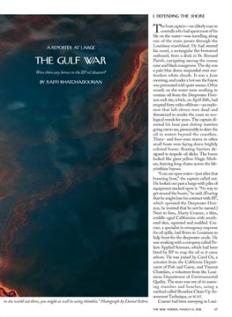 In a recent article by The New Yorker titled “Science vs. Politics In The BP-Spill Clean-Up“, journalist Raffi Khatchadourian asks “Were there any heroes in the BP oil disaster?”.
In a recent article by The New Yorker titled “Science vs. Politics In The BP-Spill Clean-Up“, journalist Raffi Khatchadourian asks “Were there any heroes in the BP oil disaster?”.
The question must be rhetorical in nature as it’s not clearly answered in the article. Those who have read my book know the answer to be overwhelmingly YES but, unlike my book, the article is focused on the clean-up, not the disaster itself.
In covering the clean-up efforts for this blog I was highly discouraged by the sound bites picked up by journalists and plastered as headlines on newspapers nationwide. Many where simply false. Others misrepresented the truth. This particular article is the exception as it’s well researched and takes it’s time to answer questions otherwise ignored. For example – the primary reason dispersants where injected at the wellhead of Macando was not to prevent it from reaching shore or to hide the oil in undersea plumes, as many journalists previously suggested, but to prevent the build-up of oil and reduce LEL levels around the ships working to kill the well. This fact was reported by gCaptain but Raffi is the first mainstream journalist I’ve read who clearly points this fact out.
He also puts much of the response in perspective. The following are two short clippings of interest:
In just half a year, the response expended nearly sixty million man-hours, roughly nine-times what it took to build the Empire State Building.
When hydrocarbons flow into the sea – whether from spills, or leakuy slhips, or natural seeps – experts call them “petroleum input.” The world’s total petroleum input is thought to be about three hundred and eghity million gallons per year – a quantity similar to the catastrophic Gulf War spill.
We will excuse Raffi Khatchadourian for not highlighting the efforts at the wellsite (many of which where performed by gCaptain members) and for not answering the hero question directly…. as it’s clear from his article, and the response gCaptain community, the answer is yes. And thank him for providing a non-biased look at the efforts to clean-up the gulf.
(Via Mario Vittone)

 Join The Club
Join The Club












